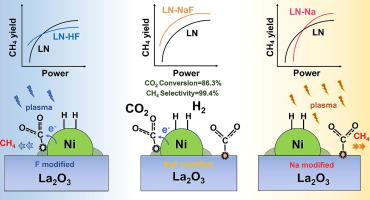Insight into plasma-catalytic CO2 methanation mechanism at Ni-Ov-Ni and basic sites in NaF-modified Ni/La2O3 catalysts with excellent activity
IF 14.9
1区 化学
Q1 Energy
引用次数: 0
Abstract
Large-scale CO2 emissions have exacerbated the greenhouse effect, reinforcing the critical need for efficient CO2 mitigation methods. Plasma-catalytic technology enables CO2 conversion under mild conditions, especially for CO2 methanation (the Sabatier reaction), which has attracted significant attention due to its economic benefits and the potential for safe energy transportation via existing natural gas pipelines. The development of high-performance CO2 methanation catalysts remains an ongoing and long-term objective, and there is a lack of adequate in-situ characterization techniques to investigate the mechanisms. This study focuses on the Ni/La2O3 (LN) catalyst and introduces two CO2 activation strategies through F and Na modifications: the Ni-Ov-Ni site activation with electron transfer from Ni0 under low-power conditions and basic site activation under high-power conditions. The LN-NaF catalysts enhance CO2 methanation activity across the entire power range compared to LN, achieving a CO2 conversion of 86.3 % and CH4 selectivity of 99.4 %. Additionally, LN-F(h) reaches a CH4 yield 4.15 times higher than that of LN at low power. Furthermore, in-situ diffuse reflectance infrared Fourier transform (DRIFT) spectroscopy with a self-made reactor are performed under plasma-catalytic conditions to reveal the CO2 adsorption and conversion mechanisms, indicating that different dopants (F, Na, and NaF) exhibit promoting effects on different intermediates, resulting in variations in CO2 methanation activity. This study provides valuable insights for improving catalyst performance and a thorough comprehension of mechanisms in CO2 methanation.

Ni- ov -Ni和碱性位点等离子体催化CO2甲烷化机制的研究
大规模二氧化碳排放加剧了温室效应,因此迫切需要有效的二氧化碳减缓方法。等离子体催化技术可以在温和的条件下实现二氧化碳转化,特别是二氧化碳甲烷化(Sabatier反应),由于其经济效益和通过现有天然气管道安全运输能源的潜力,引起了极大的关注。高性能CO2甲烷化催化剂的开发仍然是一个持续和长期的目标,并且缺乏足够的原位表征技术来研究其机制。本研究以Ni/La2O3 (LN)催化剂为研究对象,介绍了两种通过F和Na修饰的CO2活化策略:低功率条件下Ni0电子转移的Ni- ov -Ni位点活化和高功率条件下碱性位点活化。与LN相比,LN- naf催化剂在整个功率范围内提高了CO2甲烷化活性,实现了86.3%的CO2转化率和99.4%的CH4选择性。在低功率下,LN- f (h)的CH4产率是LN的4.15倍。利用自制反应器在等离子体催化条件下进行原位漫反射红外傅里叶变换(DRIFT)光谱分析,揭示了CO2的吸附和转化机理,表明不同的掺杂剂(F、Na和NaF)对不同的中间体表现出促进作用,从而导致CO2甲烷化活性的变化。该研究为提高催化剂性能和深入了解二氧化碳甲烷化机理提供了有价值的见解。
本文章由计算机程序翻译,如有差异,请以英文原文为准。
求助全文
约1分钟内获得全文
求助全文
来源期刊

Journal of Energy Chemistry
CHEMISTRY, APPLIED-CHEMISTRY, PHYSICAL
CiteScore
19.10
自引率
8.40%
发文量
3631
审稿时长
15 days
期刊介绍:
The Journal of Energy Chemistry, the official publication of Science Press and the Dalian Institute of Chemical Physics, Chinese Academy of Sciences, serves as a platform for reporting creative research and innovative applications in energy chemistry. It mainly reports on creative researches and innovative applications of chemical conversions of fossil energy, carbon dioxide, electrochemical energy and hydrogen energy, as well as the conversions of biomass and solar energy related with chemical issues to promote academic exchanges in the field of energy chemistry and to accelerate the exploration, research and development of energy science and technologies.
This journal focuses on original research papers covering various topics within energy chemistry worldwide, including:
Optimized utilization of fossil energy
Hydrogen energy
Conversion and storage of electrochemical energy
Capture, storage, and chemical conversion of carbon dioxide
Materials and nanotechnologies for energy conversion and storage
Chemistry in biomass conversion
Chemistry in the utilization of solar energy
 求助内容:
求助内容: 应助结果提醒方式:
应助结果提醒方式:


